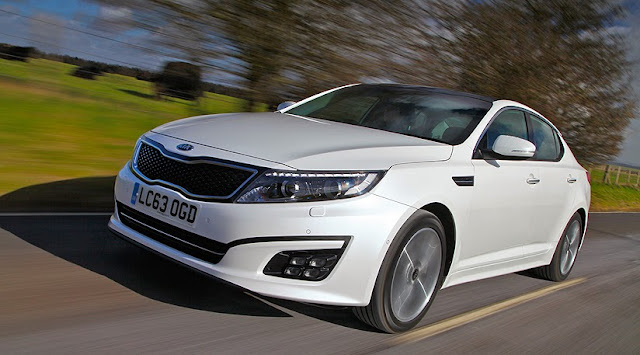
This is the enhanced-for-2014 Kia Optima, the Korean company’s diesel-only riposte to the sector Ford and Vauxhall once dominated with the Mondeo and Vectra, but now ruled by the BMW 3-series. If you’ve never seen one of these stylish saloons zip past you on the motorway, you’re probably not alone. They’re as rare as mermaids’ toes - Kia shifted just 507 Optimas in the UK in 2013, but anticipates sales to climb to 1000 in 2014, a growth spurt helped by a mild facelift.
There are two reasons for this poor sales record. The first is restricted supply from Kia’s Hwasung plant in Korea, where serious domestic and North American demand – the Optima was Kia’s fourth best-selling model in 2013 with 255,383 vehicles sold – results in stingy shipments to the UK. The second , and the big challenge for Kia’s marketing department, is to get the Optima onto the corporate buyer’s radar. Tricky when mid-ranking company car drivers have plenty of supposedly premium European metal in their price bracket.
All UK models are powered by Kia’s 1.7-litre common-rail diesel engine, hooked up to either a six-speed manual or six-speed automatic transmission. There’s no petrol-power on offer now, nor is the advanced hybrid model on sale in parts of Europe and America available. The Optima follows Kia’s familiar 1, 2 and 3 spec tier, and we drove a manual in top-spec 3 guise.
Not at all. The Optima is a cleanly stylish and distinctive-looking saloon that manages to combine imposing dimensions and spot-on proportions with more than a healthy helping of visual dynamism and flair. To keep it looking fresh, the Optima gets new front and rear bumpers, new headlamps – including the same distinctive and cool ice-cube DRLs as the Ceed GT we recently drove – as well as new tail lights and a reworked boot lip. It’s another Peter Schreyer job that looks better and better the more you look at it.
Is the cabin all plastic leather and formica wood?
Not at all. It’s luxuriantly spacious aboard and, one of two bits of unappealing bits of plastic aside, the cabin feels plush, expensive and tactile. Sitting at the top of the spec podium means the 3 is corpulent with kit. Bi-xenon headlamps, heated and cooled front seats, panoramic sunroofs, glossy dark wood that doesn’t look like a melted Mars bar and a raft of advanced safety gear that includes Blind Spot Detection, Lane Keeping Assist System and Rear Cross Traffic Alert.
That last one warns of traffic moving behind the Kia when it’s reversing, rather than irate tailgaters. Special mention too for the superb 550W 12 speakers Infinity sound system. Perfect for vibrating the windows of the car next to you with a bit of Swedish House Mafia.
Much of the criticism levelled at the Optima when it arrived in February 2012 was lower levels of refinement and sub-standard front seats. The all-new front chairs are now bigger and more supportive, while new dampers on the rear cross member, enhanced dashboard seals and improved sound-insulating carpeting have made the cabin more hushed on the go.
So, it looks good and feels good. Does it all fall apart the moment it turns a wheel?
We won’t beat around the bush here – the Optima lacks the dynamism of the Mondeo and the balance of the 3-series. This is a car made for easily lapping up thousands of motorway miles a month, not for setting new times on the A39 from Minehead to Barnstaple. With an output of just 134bhp, that 1685cc engine may sound a little weak-kneed for a big 1560kg saloon, but get it spinning above 2000rpm and there’s 239lb ft of twist action to haul the Optima long at a decent clip.
At fast cruising speeds that diesel engine is all but silent, the ride quality is comfortably absorbent and the cabin is a fine and restful place to pass the time. Pity the steering is so overly light and vague. Driven with brio over a fast A-road the Optima feels composed and agile for a car of its size, but pushed beyond its well defined dynamic limits and it feels out of sorts.
But then this is a motorway pounder, isn’t it?
Correct. Put it this way, if we racked up 2000 miles a month or more, we’d think hard about saying no to this Optima with all its relaxed and loping ride quality and vast array of fell-good kit, and saying yes to a basic spec 320d. That’s from a driver’s perspective. When it comes depreciation though, that’s another conversation…
Verdict
The Optima is a far better car than its lowly sales figures would suggest. Yes, at £25,595 it’s comparatively expensive – although we’re certain a Kia sales manager would offer you a massive discount if you showed even the slightest interest in it – but given its appealing combination of style, performance, comfort and equipment, we’re certain many Passat, Mondeo and Vectra drivers wouldn’t think twice about adding the Optima to their company car shortlist. If they knew it existed, that is.
Statistics
| How much? | £25,595 |
|---|---|
| On sale in the UK: | Now |
| Engine: | 1685cc 16v in-line 4cyl, turbocharged, 134bhp @ 4000rpm, 239lb ft @ 2000-2500rpm |
| Transmission: | Six-speed manual, front-wheel drive |
| Performance: | 10.2sec 0-62mph, 125mph, 57.6mpg, 128g/km CO2 |
| How heavy / made of? | 1559kg/steel |
| How big (length/width/height in mm)? | 4845/1830/1455 |
CAR's rating
Source:
By Ben Whitworth
First Drives
http://www.carmagazine.co.uk/



0 komentar:
Post a Comment